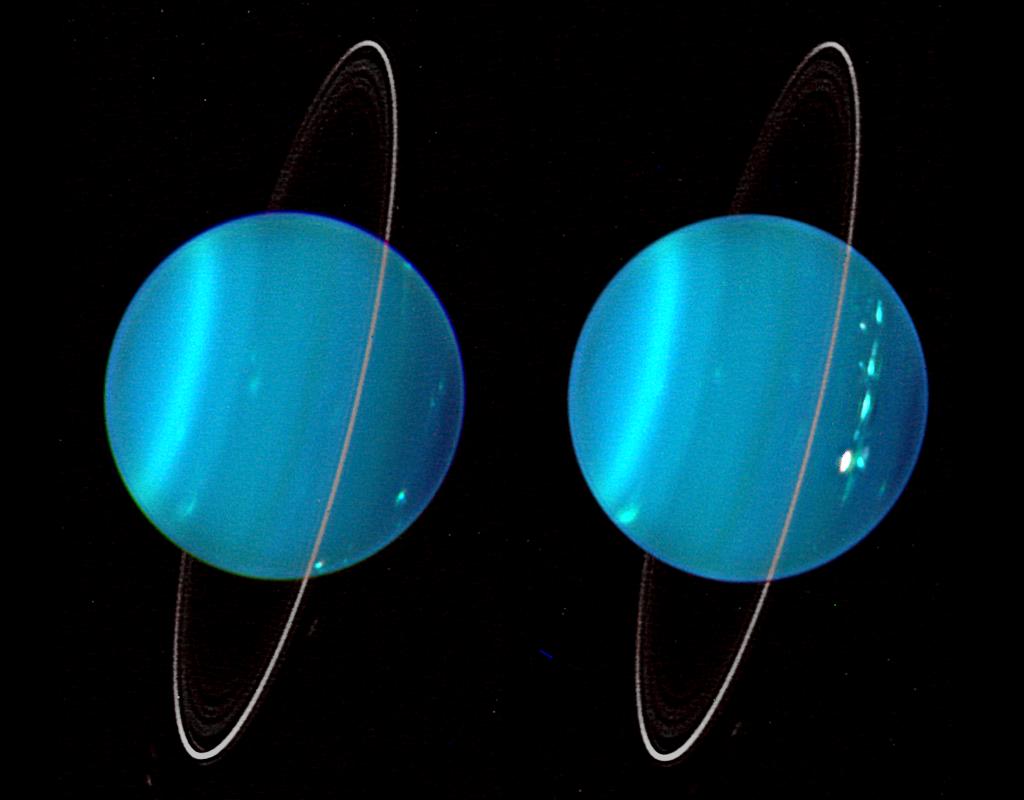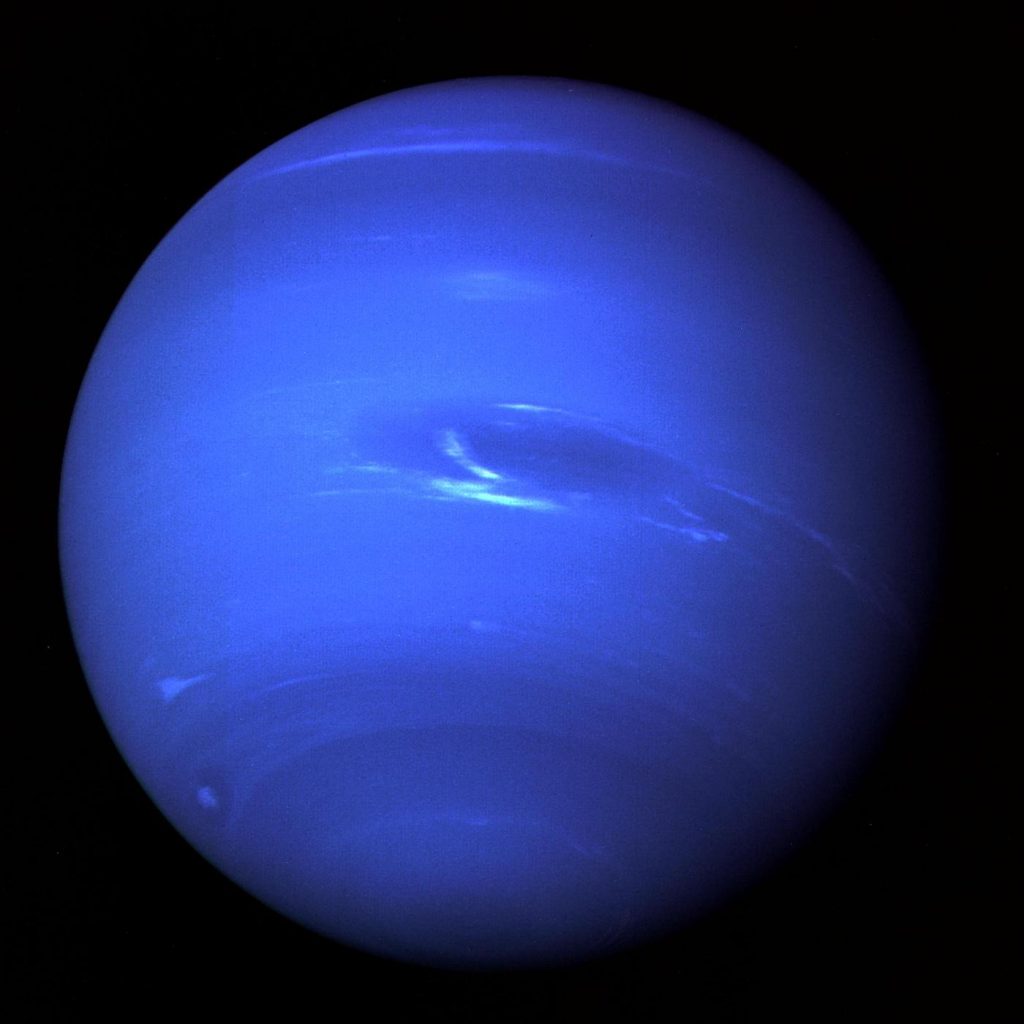Our Solar System: Uranus and Neptune

Uranus and Neptune, the twin ice giants of the solar system, are so far out there that they’ve only been visited once by Voyager 2 in 1986 and 1989. They’re so far away that light from the Sun takes two-and-a half hours to reach Uranus and over four hours to touch Neptune. For those reasons, not much is known about the planets. As with Jupiter and Saturn, their fellow gas giants, they’re made mostly of hydrogen and helium, with a splash of nitrogen and methane to give them their bluish colors. Both Uranus and Neptune are about the same size, four times the size of Earth. Like the other gas giants, winds whip around the two planets with surprising speed. In fact, Neptune has the record for fastest winds, more than 1,000 mph! It has also sported a great dark spot, similar to Jupiter’s great red spot. This was spotted when Voyager 2 passed by the planet, but recent telescopic views of Neptune show that the spot is gone.
Uranus is an oddball of the solar system – it lies on its side, probably due to a massive collision early in the solar system’s history. It also has a thin-ring system and at least 27 moons, each one named after a character in Shakespeare’s plays. All of the moons are mixtures of ice and rock, and four of the largest moons— Titania, Oberon, Miranda, and Ariel— show signs of some activity such as fracturing. Miranda may even have been blown apart then re-integrated sometime in the distant past.
Uranus was the first planet discovered with a telescope, as it was by William Herschel in 1781. Neptune took another 65 years to be found. It was discovered after a French astronomer, Urbain Jean Joseph Le Verrier, learned that perturbations in Uranus’ orbit could be explained by the presence of a ‘planet x’ beyond Uranus. Using his calculations, he predicted where Neptune could be found in the night sky and his German colleague Johann Gottfried Galle found it.
Kurt Vonnegut on Neptune?
Triton held some surprises for analysts of Voyager’s images. Black, wispy plumes were discovered draped across the icy surface. The best explanation for these transient features is that the Sun’s fire may be enough to heat Triton’s frozen nitrogen crust and release pent-up gasses along with dust. It’s amazing that at -350° Fahrenheit there could be any activity at all!

Neptune also has a set of thin rings and at least eight moons. The largest, Triton, is about the size of our moon. It was probably captured from the Kuiper Belt, a collection of objects that includes Pluto (more on them next time). While Triton’s surface is mainly frozen nitrogen, its interior appears to be mostly ice and it’s large enough to compress ice into different crystal configurations deep in its interior. Those configurations have been given Roman numerals; it turns out that one of those is called ice IX. Readers of Kurt Vonnegut’s book Cat’s Cradle may recognize the name as a dangerous substance, but the real thing is not much different than regular ice.
After passing Neptune, Voyager 2 turned its camera back at Earth. A pale blue dot was captured, inspiring Carl Sagan to write: “That’s here. That’s home. That’s us. On it everyone you love, everyone you know, everyone you ever heard of, every human being who ever was, lived out their lives.” Voyager 2 then joined its twin on the Voyager Interstellar Mission. Traveling at about 35,000 mph, they are now over 10 billion miles away from Earth. In about 40,000 years, Voyager 2 will pass close to a star in the Andromeda constellation and in about 300,000 years, Voyager 1 will approach a star in the constellation of Cygnus.
Because the spacecraft will likely survive many thousands of years, NASA set up a committee chaired by Sagan to develop an artifact that could provide information about the society that created them. A ‘Golden Record’ was designed with information about the Earth’s location even though there was some debate about whether to let the finders know where we were. Other information included pictures of humans and other life forms, sounds, and greetings in many languages. The contents can be explored at https://voyager.jpl.nasa.gov/golden-record. It’s interesting to consider what you may have included to tell an alien intelligence about us.
So Many Questions
Since Uranus and Neptune have been visited only once, many proposals have been floated to revisit them. But because it takes over 10 years to reach them, it’s a tough sell. About every decade, NASA hosts a Decadal Survey of planetary science during which researchers try to prioritize the next mission. Trips to both Uranus and Neptune have been advanced with proposals consisting of orbiters and atmospheric probes. A Triton Hopper has also been proposed to investigate that unique satellite. Currently, the highest priority for the two ice giants is a Uranus Orbiter and Probe, but it has a long way to go as funding priorities tend to budget shorter missions to the inner planets such as Mars and Venus as well as a new focus on Ocean Worlds. Many questions about the two outermost planets are still open, such as details on the composition of their atmospheres and interior structures; dynamics of the rings and moons; if there is any tectonic or cryo-volcanic activity on the moons; or if any of the moons have a subsurface ocean similar to Jupiter’s Europa and Ganymede.







